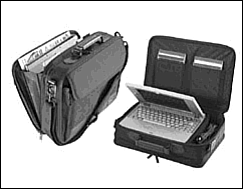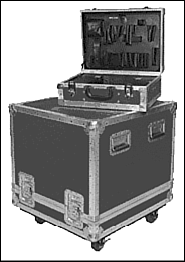Carrying Cases
| Perhaps the most popular accessory for laptops is the carrying case ”and for good reason. Anyone who takes an expensive laptop computer out into the real world wants to be sure it will survive undamaged. People can and do carry their laptops in briefcases, backpacks, and probably everything short of a paper grocery bag, but for real protection, laptops should be carried in cases specifically designed for that purpose, with special cushioning to limit any damage from accidental knocks and drops . Over the years , several different types of cushioning have been employed in laptop carrying cases. The simplest and most common form of cushioning is a layer of foam rubber. A handful of cases have enhanced this type of cushioning by suspending the laptop in an elastic sling. A small number of other carrying cases used inflatable cushions. The inflatable cases provided a good degree of cushioning but often required partial deflation in order to remove the laptop. It is difficult to get an exact measurement of the cushioning capability of a carrying case without doing extensive drop testing. You can, however, obtain a rough estimate of the cushioning simply by squeezing the side and bottom walls of the case. Of course, the thicker the walls, the better. The foam should be soft, but not too soft. The bottom should be thicker than the sidewalls. One of the most common ways a laptop is damaged is by failure of the carrying case's shoulder strap, causing the case to plummet to the ground. Be sure that the fixtures of the shoulder strap are composed of sturdy metal and not plastic. The carrying capacities of cases vary considerably. Most have several pockets designed for different purposes. The largest pocket is designed for the laptop and is usually the only one that is cushioned. A few of the larger cases have a second large cushioned pocket for devices such as a portable printer. At least one smaller pocket is also available for carrying items such as power supplies and phone cables. Because you will probably be carrying a considerable quantity of paper as well as your laptop, look for a case with a pocket that can easily accommodate a folded newspaper or a few magazines. In fact, when you shop for a carrying case, it is a good idea to bring along not only your laptop but a newspaper as well. Many different types of carrying cases are currently available. Table 14.1 lists the most common types. Table 14.1. Laptop Carrying Cases: Several Different Types of Cases Are Designed for Various Applications and User Profiles
The following sections discuss each of these case types in further detail. Nylon CasesThe most inexpensive type of laptop carrying case is the soft-sided nylon case. This case is simple, lightweight, and usually has ample storage capabilities for laptop accessories and papers, along with good cushioning (see Figure 14.1). Figure 14.1. The Targus NotePac, a popular nylon carrying case for notebook computers. Although nylon carrying cases are affordable and practical, they suffer from two problems. The first is that are usually an open advertisement that you are carrying a laptop and therefore represent an inviting target for theft. This can be a considerable problem in certain areas of the world. The second problem is that nylon cases do not age well. After a year or so of use, the case will have a crumpled look that may be inappropriate for certain high-level boardrooms. Leather CasesThis is the carrying case for the laptop-toting executive. Slightly heavier than the nylon cases, these expensive cases do not offer any additional cushioning, but they look much better in the corner office. Note that leather cases tend to have smaller carrying capacities than nylon cases. Backpack CasesIn high schools and on college campuses, the standard carrying case is the backpack. For this audience, there are now backpacks that have special cushioned pockets for notebook computers. One of the best features of these cases is that they completely disguise the fact that you may be carrying a laptop. Note that despite the cushioning, a dropped backpack can still damage your laptop. Be sure that the shoulder straps are of sufficient quality. Wheeled CasesOne of the greatest advances in luggage history was the development of the wheeled suitcase. Now we have wheeled computer cases, which come in quite handy when you need to drag around a laptop plus a projector, printer, camera, or a multitude of other accessories. I personally use a two-case setup from Targus called the Shuttle, which features a large rolling case with a smaller internal satellite case (see Figure 14.2). This type of case fits my needs perfectly . Most of the time I travel to a client's location to either teach a class in the client's office or training room or to work on the client's systems for several days while staying at a local hotel. With the large roller case I can bring everything I need, and yet easily take my laptop back to my hotel room every night in the smaller satellite case. Figure 14.2. The Targus Shuttle, a large roller case with a smaller laptop case inside. This case is the largest possible that conforms to the FAA regulations for overhead storage, so I can take it with me on a plane when I travel. This allows me to take all my mobile accessories, tools, cables, discs, and so on, to a work site and then travel locally with only my laptop in the smaller case. The Shuttle includes handles on the top and side for easy carrying, and it has an adjustable telescopic handle for wheeled use. The wheels are inline skate wheels with ball bearings that roll extremely well over most surfaces. The case features two main compartments that are fully lined and padded , with one of them including an adjustable divider. There are also mesh pockets in both compartments for smaller accessories, as well as pockets for CDs, floppy/Zip disks, PC Cards, pens, and more. The zippers are self-healing and have metal pulls with a hole for a small lock or zip tie. The side of the case even has additional external pockets for documentation, papers, and smaller items. This particular "case within a case" setup suits my needs perfectly. Ruggedized CasesIn some environments, the soft-sided cases will not do. Here you will need one of the rigid cases, made either of metal or hard nylon backed by extra cushioning. Note that all this protection costs money, sometimes even more than fancy leather cases cost. If you want the ultimate in cases, consider buying one that meets ATA (Air Transportation Association) Specification 300 standards (see Figure 14.3). Such a case is often called an "ATA flight case" or sometimes just a "flight case." The ATA was founded in 1936 and is the first and only trade organization for the principal U.S. airlines. ATA Spec 300 reviews the design, development, and procurement of effective packaging of supplies shipped to a customer airline. These approaches also serve as guidelines for shipping containers acceptable for air transport. Cases conforming to ATA Spec 300 standards are able to survive a minimum of 100 air shipments, including any of the ground transportation associated with each shipment. Figure 14.3. ATA Spec 300 cases from Anvil Case. The cases used by musical groups and trade-show exhibitors to transport their equipment are usually ATA cases. As you can imagine, ATA cases are extremely durable but also very heavy. They are normally made out of reinforced plywood and metal or special heavy-duty plastics. They have solid foam interiors that can be cut or shaped to fit your equipment exactly, thus protecting it and not allowing things to move around or bang together. ATA cases often have clip-on wheels for transportation, and some are even water tight with gasket seals on the lid. They almost always have special latches and locks for security. ATA cases are ideal for those who ship their laptops or other computer equipment from place to place and want them to arrive intact and in working order. One of the best-known ATA case companies is Anvil Case (www.anvilcase.com). |
EAN: 2147483647
Pages: 182


